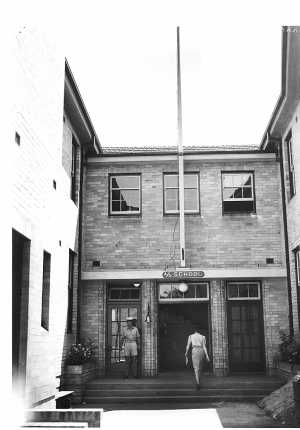- Author
- Cleary, Brian, Commodore, RAN (Rtd)
- Subjects
- Naval technology, Ship histories and stories, History - Between the wars
- Tags
-
- RAN Ships
- HMAS Rushcutter (Shores establishment)
- Publication
- June 2006 edition of the Naval Historical Review (all rights reserved)
HMAS Rushcutter
During 1940, the changes were made and the school settled down to a maximum capacity training programme hampered only by the continuing lack of residential accommodation and a shortage of training equipment. A new Attack Teacher and Mass Procedure Teacher were on order from the UK. Asdic Types 127/128 were received. These types were essentially the same except that Type 128 was fitted with internal dome retracting machinery whereas Type 127, like its predecessor Type 123, had to be raised or fitted by external means. With the war, there was little use made of the Reserve Depot and the site, including the School, was commissioned as HMAS Rushcutter on 1 August 1940.
Increased training load
In March 1941, the eastern wing extension was completed but the spaces allocated for the new Attack Teacher and Mass Procedure Teacher were used as temporary classrooms pending the delayed arrival of the equipment. The training load increased greatly. In addition to RAN requirements for an expanding Asdic-fitted escort force, the School was instructing increasing numbers of New Zealand officers and sailors. The first course for Higher Submarine Detector (HSD) sailors was conducted. The flow of officers and sailors to the Royal Navy continued unabated.
In addition to Commander Newcomb and his small team of RN Instructors, the staff of the School had grown to include 15 officers and six sailors for training and administration duties. Of the three RN Chief Petty Officers, one was allocated to Asdic training, one to supervising the Australia-wide ship fitting of Asdic equipment and the other to overseeing harbour A/S defences, particularly the installation and operation of Indicator Loop Systems.

(Photo: NHSA Archives)
The entry of Japan into the War in December 1941 further increased the A/S training load. The School found it necessary to impose a two-shift day of 0830 to 1600 and 1300 to 1830 to manage a training load increased by training for US, Dutch, Free French and Indian Navies. The School was also required to accommodate instruction in Radio Direction Finding (RDF – later known as ‘Radar’).
Disruptions to supplies of equipment from the UK made it necessary for local production of Asdic and RDF material. Production design staff and workshops were located in the Sayonara building located next to the south boundary of the depot. Late in 1942, A/S training began for officers and sailors to man the Fairmile Class of Coastal Patrol boats. These were all fitted with Asdic Type 134, similar to but smaller than Type 128. Space for the Fairmile School was not available within the Depot, and after a prolonged dispute with the Woollahra Council, timber buildings were constructed in Yarranabe Park, on the northern boundary.
In January 1943, Commander Newcomb’s command responsibilities included the following:
- Gunnery Instruction Centre at Woolloomooloo
- A/S School
- RDF School at South Head
- Fairmile School, and
- Naval Auxiliary Patrol Service (NAP) as well as
- equipment procurement staff.
The NAP consisted mainly of private motor cruisers manned by their owners and other volunteer civilians. These boats carried out harbour patrols and some were fitted with Asdic sets operated by RAN sailors. They particularly distinguished themselves during the 1942 raid by Japanese 2-man submarines.
After completion of the Fairmile building in 1943, accommodation huts were also built in Yarranabe Park. The building of Bathurst Class Australian Minesweepers (AMS – more commonly known as corvettes) continued, and their A/S command and control teams trained in the Attack Teachers. In addition to the usual course for SDs and HSDs, the first SDIs were trained in Australia in 1943. HMA Submarine K9, formerly a Dutch submarine, became the dedicated sea target for all training classes.
Ahead-throwing weapons
The great demands on staff and equipment continued into 1944. In the UK, the development of ahead-throwing weapons (ATW) had proved most successful, with an improved Asdic Type 144/145 replacing Type 127/128. A Type 144 set was received at the School and was fitted to the Attack Teacher. HMA Submarine K9 was taken out of service early in the year, but limited sea training was available with a US submarine off Brisbane.
Perhaps the most rewarding event of 1944 was the promotion of Newcomb to Captain.
Although training commitments continued to be heavy at the start of 1945, they soon began to diminish. The Fairmile School stopped training as coastal and harbour defence needs reduced. With VE Day in May, there was a steady flow of RN and RAN ships coming through Sydney as part of the British Pacific Fleet. Team training in the A/S School became the main load. After VJ Day in September, training was mostly concerned with providing replacement personnel for those Reserve operators being demobilised.




